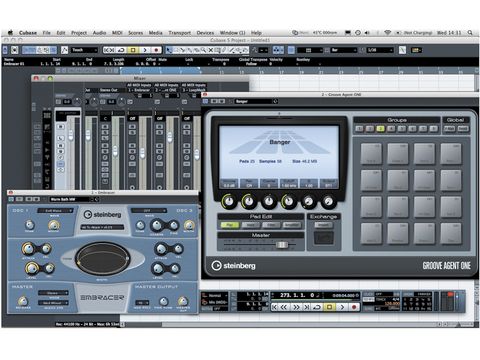TechRadar Verdict
Traditional sequencing and production with some creative new features – it's powerful but pricey
Pros
- +
Creative new features
- +
Orchestral sequencing
- +
Powerful drum and loop tools
Cons
- -
Expensive
- -
Not completely stable
- -
Supports VST plug-ins only
Why you can trust TechRadar
This is the 25th year of Cubase, and, instead of celebrating with a cake decorated with MIDI leads and jack-plugs, Steinberg have produced one of their most intriguing updates yet.
Cubase 4 was slated for being less than bulletproof. Now that there's been time for the VST3 plug-in technology to settle down and to swat a few bugs, Cubase 5 is focussed on adding creative features.
With loops and drum sounds playing such a huge role in music, there's a new drum sampler called Groove Agent One, which lays out 64 samples on virtual pads. The clever feature here is ease of use.
You can assign any of the virtual pads to any sound, and then edit pitch, volume, pan and filtering with a few mouse clicks. Setting up drum sounds on a keyboard-oriented sampler can be torture in comparison. Paired with Groove Agent is a new rhythm programming MIDI plug-in, which must be one of the most intuitive and musical grid editors we've seen.
If you want more loop action there's a new loop mash-up effect – called LoopMash, oddly enough – which semi-randomly slices and dices grooves into other grooves. It looks good and can add creative spice to repetitive drum programming – but it takes a while to tame.
Pitch imperfect
Elsewhere in the box are some new pitch correction plug-ins. These are Steinberg's own take on the AutoTune and Melodyne effects used by professionals, and unfortunately they're more of a miss than a hit.
In theory you can convert a vocal line to an accurately pitched and modulated MIDI file with a single click. Except, in practice you can't. The core autotuning and pitch correction effects demand careful handling, otherwise you can turn your vocals into a pseudo-Cher robovoice even when you're not trying to.
A new sampled reverb plugin is more successful. Visually this looks almost obsessively detailed and designed, with photos of the locations that were sampled to create the different kinds of ambience. It sounds good, but it's not burdened with parameters – which is a good thing, because it makes it easier to get the sound you want.
Filling out the extras is a sample collection with 1.6GB of miscellaneous general-purpose loops and samples. This sounds like a lot, but most of that space is taken up with huge sampled instruments, including a grand piano.
The loop collection itself is relatively modest. Another couple of DVDs include a 16-bit version of the HALion sampled orchestra. Getting a MIDI orchestra to sound like the real thing is always a challenge, because each instrument can be played in many different ways.
Some new articulation features in the score editor emulate the essentials of this, and combined with the orchestral samples it's easy to create effective sketches that are fine for demos and for string and brass background parts. Fooling someone that they're listening to the real thing is always tricky, but this is an admirable attempt to pack an orchestra in a box. It's one of the better-sounding and more comprehensive orchestral collections – even when at 16-bit quality.
Stiff competition
The problem for Steinberg is that Apple's own Logic bundle offers so much more, and costs around £200 less.
For newcomers there's no contest – even with the new features in Cubase, Logic still wins easily. For established users, the decision isn't quite so easy. If you already have years of time and hundreds of plug-ins invested in Cubase, there's every reason to want this update. And for the few hundred people in the UK who can score orchestral music with dots on staves, the articulation features may be a real time-saver compared to other packages.
But those are limited markets, and elsewhere the competition is overwhelming. This is unfortunate for Steinberg because Cubase is a powerful music-production package.
If it had the market to itself, it would be a winner. But it doesn't, and even though the new features shine, more realistic pricing would make it much more persuasive.

